If you’re noticing signs of a blocked chimney flue such as black stains, debris inside the fireplace, or an odd smell coming from the chimney, you should get your chimney flue checked for blockage.
You don’t want to start a fire if your chimney flue is blocked. Because it can lead to smoke and Carbon Monoxide gas coming inside the room. And, in certain cases, even lead to chimney fires.
Therefore, getting your chimney flue unblocked is paramount to a safe and efficient chimney operation.
The following article provides a helpful guide on how to unblock your chimney. But before we get to that, let’s first talk about what causes a chimney blockage in the first place.
What Could Be Blocking My Chimney?
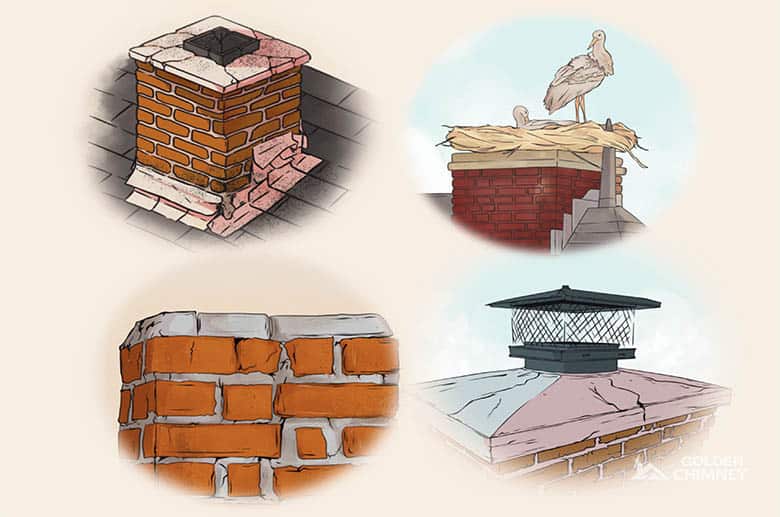
Small Animals and Birds
Birds and small animals such as squirrels, bats, and raccoons, are often found nesting inside chimney liners to protect themselves against predators. Chimney liners are also warm spaces so they’re not only great hideouts but also much better than the cold outside.
These birds and animals bring along twigs and the like to build their nests and clog the chimney liners (flue).
These tiny critters can find their way in through a damaged or broken chimney cap.
Debris
Dust and debris from outside can enter your chimney liner and collect overtime, resulting in a blocked chimney flue. That’s especially true if you’ve got a garden and trees outside since twigs, levels, and broken branches can fall off from the chimney and find their way into your chimney flue.
Soot and Creosote
Creosote is basically unburnt carbon. Since there’s always some unburnt carbon left, burning wood will produce creosote. However, if you use unseasoned wood for burning, the amount of creosote produced is drastically increased. That’s because proper combustion does not occur due to high levels of moisture content in the unseasoned wood. As a result of the partial combustion, thick, black smoke is produced which contains large amounts of soot and creosote.
Soot and creosote rise up with the black smoke and get deposited onto the inner walls of the chimney flue. Overtime, if the chimney flue is not cleaned, these deposits can become large enough to cause blockage inside the chimney liner (flue.)
Broken Chimney Bricks
While not common, broken chimney bricks can also cause a blockage inside a chimney flue. Chimney bricks can crack, deteriorate, and ultimately, start to fall off due to water damage. If there’s water leaking inside the chimney through a bad flashing, a broken chimney cap, or a damaged chimney crown, it can cause some serious damage to the inner chimney lining (flue).
——
Do You Need to Hire Chimney & Fireplace Expert?
Get free quotes from qualified experts near you. No commitment required!
——
How Do I Know if My Chimney Flue Is Blocked?
You always need to be vigilant as a chimney owner. Unlike a broken charger or a malfunctioning computer, a problem or damage inside a chimney can be serious business. Since broken and damaged chimney parts can put you, your loved ones, and your home in danger, it’s a good idea to always look out for anything unusual.
But, just to give you a heads up, if you notice any of the following signs, there’s a good chance that you’ve got a blocked chimney flue.
Smell of Smoke
A chimney flue is designed to let out the smoke and other harmful gasses while the fire is burning. However, a blocked chimney flue can’t do that properly. Since there’s a blockage, the smoke doesn’t have anywhere to go and is trapped inside your chimney flue.
So, if you smell smoke when the fire is burning, that probably means that the smoke is trapped inside your chimney flue due to a blockage.
Sometimes, things get worse and the smoke is drafted down and into your living space.
Carbon Monoxide (CO) Detector
If your Carbon Monoxide (CO) detector goes off while the fire is burning, that’s a good indication of a blocked chimney flue. A normal chimney flue should let out all the smoke and the CO produced as a result of burning. However, a blocked chimney flue can’t do that and the CO gas is drafted back into the room.
Note: A blocked chimney flue can be dangerous. So, if you notice any of these signs, do not ignite a fire. Make sure you get your chimney flue cleaned and unblocked before starting a fire.
Dirt Inside the Fireplace Hearth
Dirt and debris inside your fireplace hearth is often a sign of a blocked chimney. Debris inside your fireplace hearth means that it’s fallen off your chimney. And there’s a good chance that there’ll be more where it came from.
Black Stains on the Fireplace Walls
If you notice any black stains around your fireplace walls, that means you’ve got a blocked chimney flue.
The black stains you see are soot and creosote. If you’re seeing creosote in your fireplace, it must have fallen off from the chimney flue where there are probably large deposits of it, blocking the chimney flue.
What Happens if You Light a Fire and Your Chimney Is Blocked?
Lighting a fire can be dangerous if your chimney is blocked and should be avoided at all costs.
Here’s why:
Chimney Fire
If you light a fire and there are large amounts of creosote blocking the chimney flue, it could quickly heat up and cause a chimney fire. And chimney fires are no joke.
One of the leading causes of a chimney fire is the creosote deposits inside the chimney flue. Since creosote is essentially unburnt carbon, it is highly flammable. Other causes include debris, twigs, broken tree branches, and nesting materials brought by birds and small animals.
Now, you might think that a chimney fire shouldn’t be a big deal because a chimney should be able to withstand a chimney fire. Well, think again. Chimneys are not designed to withstand fire, they’re designed to draft out smoke and allow for adequate airflow.
A chimney fire can be disastrous as it can even break into your home. As soon as a chimney fire occurs, within a matter of minutes, the chimney flue expands, causing it to crack. The fire then escapes through these cracks and reaches nearby walls and other combustible materials inside your home. And before you know it, your whole house is burning.
Carbon Monoxide (CO) Poisoning
If you ignite a fire when your chimney is blocked, you’re putting yourself and your loved ones at risk of CO poisoning. Since a blocked chimney flue can’t vent properly, the CO gas produced as a result of combustion will have no way but to enter your room.
CO poisoning is serious business and is known to be fatal. Since CO gas is colorless and odorless, you won’t realize that it’s leaking. You might feel dizziness, nausea, headache, or have difficulty breathing. But, before you realize it, you’ll lose consciousness.
Therefore, if you don’t already, it’s a good idea to get a CO detector installed. Get one installed near your fireplace and one in each bedroom and living room.
How to Unblock a Chimney Flue?
For a safe and efficient chimney operation, it’s important to have your chimney flue clean and unblocked. But how do you go about doing that? It’s a fairly simple process if you’re not afraid to climb up your rooftop and get your hands dirty.
What You’ll Need?
- Chimney brush
- Fiberglass rods
- Safety glasses
- Protective mask
- Ladder
- Bucket
- Cord
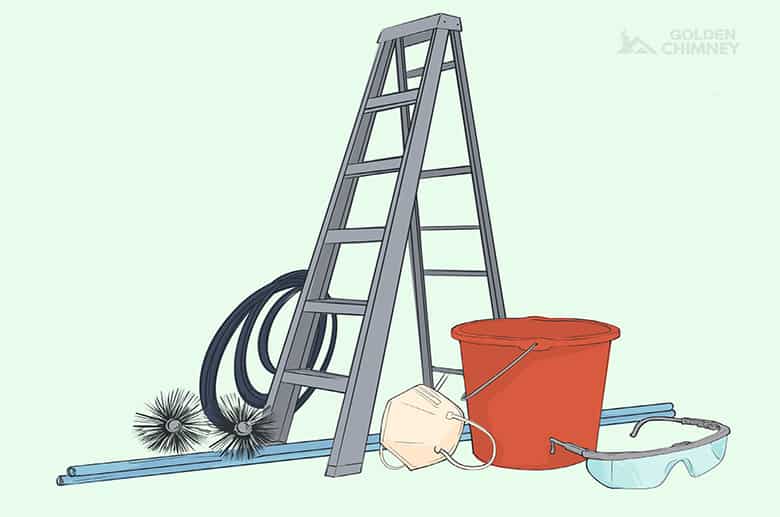
Cleaning and Unblocking Your Chimney Flue
Step 1
- Before you start with the cleaning process, make sure you close the glass doors of your fireplace and tape it off so that the debris and creosote don’t ruin your room.
- Once done, get a ladder to climb up your rooftop, and make sure you’re wearing your protective gear before getting in on the action.

Step 2
- Take the chimney cap off your chimney. You will either have to pull it off, or you’ll need to use a screwdriver to unscrew it first.
- Use a scrubbing brush to clean off any dust and debris from the interior and exterior of the chimney cap. Place the cap on the side or put it in a bucket (secure the bucket using a cord tied to the chimney so that it doesn’t fall off.)
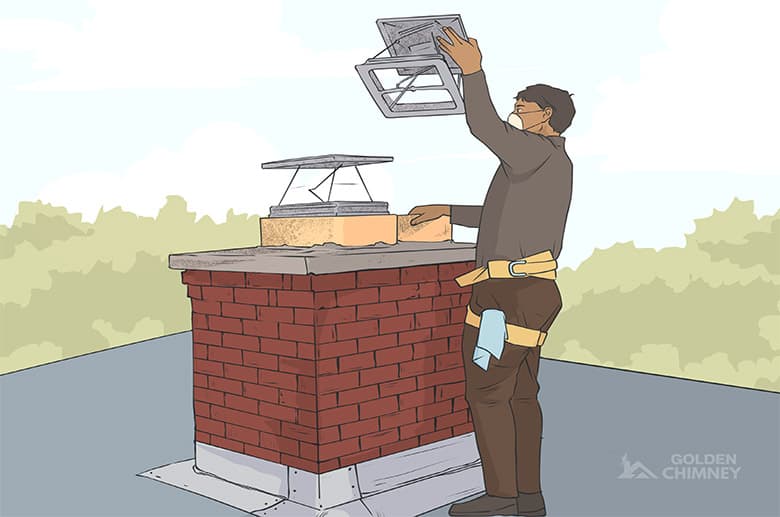
Step 3
- Take your chimney brush and connect it to a fiberglass rod. (Chimney brushes come in various shapes and sizes. Make sure you buy one that fits your chimney for the best results.)
- Now, insert the brush into the chimney top; you’ll have to push it down with force. Do a pull and push motion to move the brush downwards. You’ll need to attach a few more fiberglass rods (a single rod is 4 ft. long.) for it to reach the bottom of the chimney.
- Once the chimney brush is at the bottom, do the same motion to pull it back up.
- Repeat the process several times to get out all the dust, debris, soot, and creosote.

Step 4
- Use a flashlight to inspect the chimney, if there’s still some debris or creosote left, keep on cleaning.
- Once it’s clean, attach the chimney cap securely to the chimney top.

Step 5
- Get down into your room and place drop cloths near the chimney to protect the surrounding areas from getting dirty.
- Open the chimney damper system. Make sure you’ve got a dustbin under it to collect all the soot, creosote, debris, etc. that’ll fall off.
- Get a vacuum to vacuum out all the remnants and thoroughly clean the fireplace and damper system.
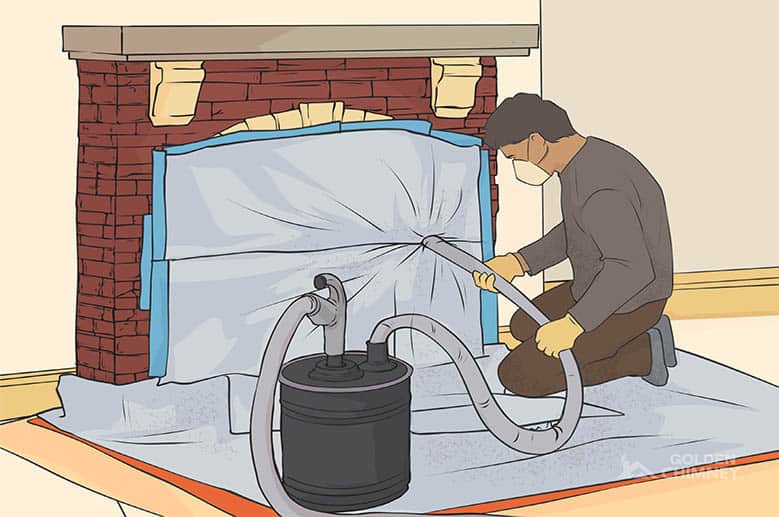
By now, your chimney should be clean, unblocked, and safe to use. Clean your chimney at the end of the winter season (spring) and before the start (fall). Regular cleaning of the chimney is essential for a safe and efficient chimney operation.
Here’s a great video on how to clean and unblock your chimney for all the visual learners out there.
Unblocking Your Chimney Flue: DIY vs Professional Service
Since the process is not that complicated, many people can clean their chimneys on their own. But is it a good idea?
Risks of Unblocking Your Chimney Flue Yourself
While it may save you some bucks, it’s too much of a hassle. But more importantly, if you unblock your chimney yourself, you might miss tricky spots or damaged chimney parts that might lead to issues in the future.
There’s also a chance that being inexperienced, you might break or damage a chimney part. For example, while reinstalling the chimney cap, you might not fit the screws right or fit them loosely, only to have your chimney cap blown off by a strong gust of wind.
——
Do You Need to Hire Chimney & Fireplace Expert?
Get free quotes from qualified experts near you. No commitment required!
——
Hiring a Professional Chimney Sweep Is Better
It’s best to get a professional chimney sweep service to get your chimney flue unblocked, cleaned, and inspected.
Certifications
A professional chimney sweep is trained, educated, and experienced in the matters of chimney inspection and cleaning. A certified chimney sweep e.g. someone that has a CSIA certification, has to go through rigorous training and testing.
Equipment
A professional chimney sweep comes equipped with all the special tools and protective gear required to do the job. You’ll see professionals using special cameras designed to inspect the tricky spots inside the chimney, to ensure that there are no problems left unchecked.
Difficulty
A chimney that hasn’t been inspected and cleaned in a long while can have various issues such as blockages, broken parts, etc. that will require special equipment and training to solve.
For example, there are three stages of creosote. While the initial stage of creosote can be cleaned off using a chimney brush, it’s harder to clean the second and third stage creosote because at these stages the creosote gets harder and sticks more firmly to the chimney. If you try to remove these later stages of creosote, there’s a chance that you might damage the chimney.
Professionals use special brushes and chemicals to extract these tougher, glazed creosote deposits.
Avoid Potential Problems
All chimneys are different and have their own set of problems depending upon their age, frequency of use, how often they have been cleaned and inspected, etc. It’s not possible for an inexperienced person to detect and solve all of these issues.
A professional chimney sweep has the experience, expertise, and equipment to detect and solve all these issues.
While the chimney sweep process not only will a professional service clean your chimney and unclog your chimney flue, it will also solve other problems that you might have, such as a malfunctioned chimney damper system, a damaged chimney crown, or a broken chimney cap.
Having these issues fixed is not only important to avoid problems before they arise, but it also saves a lot of money that might otherwise go into repairing damages.
Insurance
Professional chimney sweep services are insured. That means, that if any damage or injury occurs, it is covered. However, if you unblock your chimney flue yourself and get hurt or damage any equipment, you’ll have to bear the extra expense.
Also, in cases of house fires, you’ll have to provide proof of annual chimney inspection and cleaning to get compensated for the losses. If you have been inspecting and cleaning your chimney yourself, you won’t have any proof. And you’ll have to bear the loss incurred.
Preventing a Blocked Chimney Flue
Prevention is always better. Not only do you save yourself and your family from the potential dangers of a blocked chimney flue, but you also save a lot of money that would otherwise have been spent on repairing costs.
Here’s how you prevent your chimney flue from getting blocked:
Use Seasoned Wood
Since unseasoned wood has a lot of moisture, combustion does not occur properly. Therefore, using unseasoned food for burning produces dark, thick smoke and a lot of creosote. Overtime, the creosote deposits can become large and block your chimney flue.
Since seasoned wood has less moisture content, it burns more thoroughly, producing lesser quantities of creosote.
Install a Chimney Cap
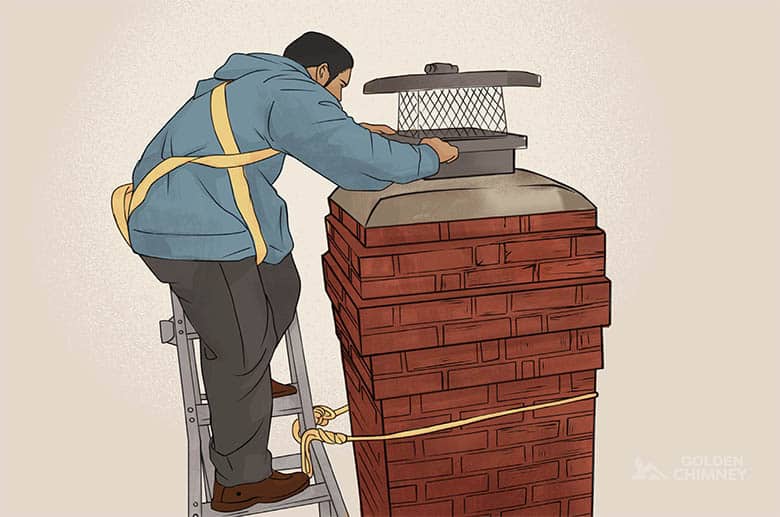
A chimney cap is your number one barrier against debris, small animals, and birds. Since these outside elements and creatures won’t be able to enter your chimney, it won’t get blocked. A chimney cap also protects your chimney against rainwater.
Annual Inspection and Cleaning
The National Fire Protection Association (NFPA) recommends having your chimney inspected and cleaned once every year. Doing so allows you to ensure that your chimney doesn’t have any underlying problems and is in its optimum condition for a safe and effective chimney operation.
Also, a chimney that’s inspected and cleaned annually has little possibility of getting blocked.
The Takeaway
A blocked chimney can be a safety risk and should be avoided at all costs. Regular cleaning and inspection of your chimney, installing a chimney cap, and using seasoned wood for burning are a few ways you can prevent your chimney from getting clogged.
However, if your chimney is blocked, you shouldn’t ignite fire as it can be dangerous and even lead to a chimney fire. It’s best to get your chimney blocked before lighting fire.
While you can unblock your chimney yourself, it’s best to hire professional help for a thorough cleaning, inspection of any potential problems, and fixing any broken chimney parts.
While hiring a professional chimney sweep, remember to ask them for certifications and if they have insurance to cover any injury or damages. Also, ask if they can provide any references to build trust.






